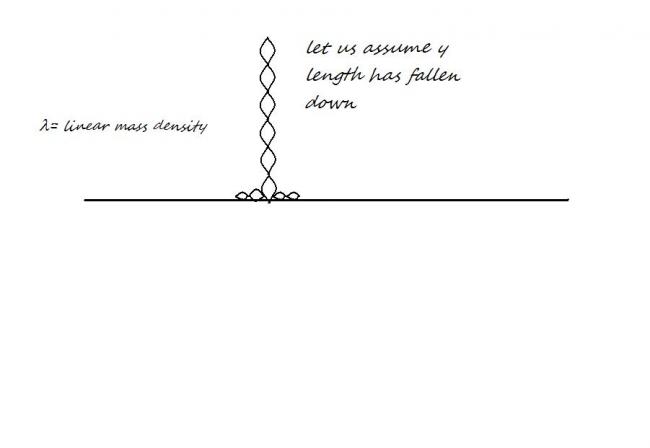thnx akari
i was solving this classical sum from irodov
a chain is tied to a thread such that the lower portion just touche the upper part of the table. now the thread is burnt
prove that the force exerted by the falling part is twice of that of the lying part
with variable mass i know the force exerted should be equal to vdm/dt but the problem is that i am not able to apply it here
the other thing which i know is that the work done by all forcex except gravity is 0 so we know the vel at some particular instant after that i am confused what force will be applied by which part and where
can anyone pls expln me how to solve the sum conceptually and why according to the solutions the thrust force =N
-
UP 0 DOWN 0 3 3

3 Answers
 \\\texttt {mass of the falling part is clearly }=\lambda(L-y)\\ \\\texttt{the thrust force means here , like the ground must apply some force to stop the momentum of chain } \\\texttt{, u can see the part , just before touching the ground has some velocity} \\\texttt{and then it becomes 0 suddenly , the impulse provided by the ground does it all }\\\ F_{thrust}=\frac{d\lambda(L-y)}{dt}.v_r \\ F_{thrust}=-\lambda\frac{dy}{dt}.v_r \\ \frac{dy}{dt}=v_r \\ F_{thrust}=\lambda v_r^2 \\ v_r^2 =2gy \\\texttt{this is coming from basic kinematics } \\ F_1=\lambda2gy \\\texttt{now the force exerted by the ground on already lying mass on table is }\\ F_2=\lambda gy \\ F_1=2F_2 \\ \\\texttt{hence proved }
\\\texttt {mass of the falling part is clearly }=\lambda(L-y)\\ \\\texttt{the thrust force means here , like the ground must apply some force to stop the momentum of chain } \\\texttt{, u can see the part , just before touching the ground has some velocity} \\\texttt{and then it becomes 0 suddenly , the impulse provided by the ground does it all }\\\ F_{thrust}=\frac{d\lambda(L-y)}{dt}.v_r \\ F_{thrust}=-\lambda\frac{dy}{dt}.v_r \\ \frac{dy}{dt}=v_r \\ F_{thrust}=\lambda v_r^2 \\ v_r^2 =2gy \\\texttt{this is coming from basic kinematics } \\ F_1=\lambda2gy \\\texttt{now the force exerted by the ground on already lying mass on table is }\\ F_2=\lambda gy \\ F_1=2F_2 \\ \\\texttt{hence proved }
u just need to realise the ground 's normal force has to do two jobs
1) balnce the weight thats lying
2) stop the momentum of the the end that just touches it
if u realise the second point , the thrust force comes into the play
and then u can easily solve the problem